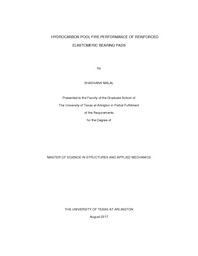
ATTENTION: The works hosted here are being migrated to a new repository that will consolidate resources, improve discoverability, and better show UTA's research impact on the global community. We will update authors as the migration progresses. Please see MavMatrix for more information.
Show simple item record
| dc.contributor.advisor | Nur, Yazdani | |
| dc.creator | Malal, Shashank | |
| dc.date.accessioned | 2017-10-02T14:06:11Z | |
| dc.date.available | 2017-10-02T14:06:11Z | |
| dc.date.created | 2017-08 | |
| dc.date.issued | 2017-08-09 | |
| dc.date.submitted | August 2017 | |
| dc.identifier.uri | http://hdl.handle.net/10106/26960 | |
| dc.description.abstract | Bearing pads are used as support for bridge girders to transfer the reaction forces to the substructure. They are designed to accommodate high axial loads from girder, shear deformations due to lateral thermal expansion of girder, and rotational deformation. Apart from these deformations bearing pads may also be subjected to thermal stresses due to daily temperature variations and extreme events like fire hazard. Current design methods do not account for these thermally induced stresses in elastomeric bearing pads.
The objective of this research is to study the hydrocarbon pool fire performance of elastomeric bearing pad. This research has three parts. The first phase involved hydrocarbon pool fire testing of a full-scale concrete bridge. Following the fire, hardness, shear modulus, compression set, and adhesion strength tests were conducted on the bearing pads as per the ASTM standards. In the second phase, the performance of bearing pads was studied by developing a thermo-mechanical analysis numerical model. Various performance parameters, such as shear strain, hydrostatic tensile strain, and bond stress were studied using linear and nonlinear material models for elastomer. In the third phase, a parametric study was conducted on different grades of bearing pad by exposing it to different temperatures and considering the effect of fillers.
All the properties of the bearing pads from the standardized tests with the exception of compression set remained within the limits. From numerical simulations, it is observed that nonlinear material behavior yielded much smaller shear strains at higher compressive loads when compared to linear elastic model and AASHTO (2014) results. From thermo-mechanical analysis, it was found that there will be significant thermal strains induced in elastomer when its temperature raises. However, it depends on many factors as magnitude of applied compressive stress, grade of elastomer and temperature. Increases of 74 %, 115 %, and 106 % in shear strain, hydrostatic tensile stress and bond stress, respectively, can be expected due to fire exposure for all grades of bearing pads, based on the level of applied compressive stress. Temperature has less contribution to shear strains beyond 50°C because of low thermal conductivity and high specific heat of elastomer, insulating interior parts of elastomer to external changes in temperature. | |
| dc.format.mimetype | application/pdf | |
| dc.subject | Elastomeric bearing pads | |
| dc.subject | Hydrocarbon pool fire | |
| dc.subject | Parametric study | |
| dc.subject | Bridge fire | |
| dc.subject | Numerical modeling | |
| dc.title | Hydrocarbon Pool Fire Performance of Reinforced Elastomeric Bearing Pads | |
| dc.type | Thesis | |
| dc.degree.department | Civil Engineering | |
| dc.degree.name | Master of Science in Civil Engineering | |
| dc.date.updated | 2017-10-02T14:06:18Z | |
| thesis.degree.department | Civil Engineering | |
| thesis.degree.grantor | The University of Texas at Arlington | |
| thesis.degree.level | Masters | |
| thesis.degree.name | Master of Science in Civil Engineering | |
| dc.type.material | text | |
| dc.creator.orcid | 0000-0001-5469-5547 | |
Files in this item
- Name:
- MALAL-THESIS-2017.pdf
- Size:
- 4.538Mb
- Format:
- PDF
This item appears in the following Collection(s)
Show simple item record


